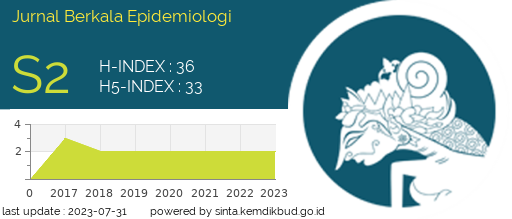EVALUATION OF DIARRHEA SURVEILLANCE SYSTEM IN MAGETAN REGENCY HEALTH OFFICE 2023 USING SURVEILLANCE ATTRIBUTES
Evaluasi Sistem Surveilans Diare di Dinas Kesehatan Kabupaten Magetan Tahun 2023 Berdasarkan Atribut Surveilans

Downloads
Background: Diarrhea prevalence in 2023 in Magetan Regency was reported for all age groups at 59.40% and for children under five at 96.53%. The preliminary study found several problems in the recording and reporting system of Diarrhea in the Magetan Regency. Purpose: To describe the quality of the diarrhea surveillance system implemented in Magetan Regency Health Office based on surveillance system attributes assessment. Methods: Descriptive research with an evaluation study design. An evaluation was conducted on the diarrhea surveillance system in 2023 in the Magetan Regency Health Office. The respondents of this study were 23 people. Data was collected using questionnaires through Google Forms, interviews, and document studies. Data analysis was carried out and presented descriptively using tables and narratives. Results: Evaluation of the diarrhea surveillance system based on the assessment of surveillance attributes shows that the diarrhea surveillance system in Magetan Regency is simple, flexible, of high data quality, sensitive, highly acceptable, timely, and highly stable. However, the system is not representative, and the positive predictive value cannot be calculated. Conclusion: The implementation of the diarrhea surveillance system in Magetan Regency has been running well, mostly supported by the completeness of surveillance attributes. The evaluation results show that the system is simple, flexible, has high data quality and acceptability, is sensitive, timely, and highly stable. However, the system is not representative, and the PVT cannot be calculated.
World Health Organization. Vol. 30, Tropical Doctor. 2019. p. 170–2 Diarrhoeal disease.
Ministry of Health of the Republic of Indonesia. Indonesia's health profile 2023. Jakarta; 2024. 310 p.
Health Development Policy Agency. Indonesian health survey (SKI) in figures, accurate data, appropriate policies. 2023.
Magetan Regency Health Office. Health Service Profile. 2023.
Ministry of Health of the Republic of Indonesia. Diarrhea management guidelines. In: Jurnal Sains dan Seni ITS. 2017. p. 51–66.
Florentji Adel Benu F, Atoillah Isfandiari M, Pramono E. Tuberculosis surveillance system evaluation in Blitar district: study of system approach and attributes. J Berk Epidemiol. 2024 Jan 26;12(1):88–97.
CDC. Updated guidelines for evaluating public health surveillance systems. MMWR. 2001;50(13):1–35.
Sono RH, Sari RDP, Lisiswanti R, Romulya AI. Factors influencing the effectiveness of HPV immunization program management in preventing cervical cancer. Action Research Literate. 2024.
Parmi & Daleng. Evaluation of the surveillance program at the West Ampana Community Health Center. J Ilm Kesehat Masyarakat-IJ. 2020;2(20):73–9.
Marsot M, Durand B, Hammouda W Ben, Ammar HH, Zrelli M, Khorchani R. Evaluation of human resources needed and comparison with human resources available to implement emergency vaccination in case of foot and mouth disease outbreaks in Tunisia. Epidemiology and Infection. 2020.
Susanti N, Simamora L, Andira AD, Erwina BP, Sagala NA. Evaluation and implementation of the epidemiological surveillance system for infectious diseases at the class I Port Health Office in Medan in 2022 in the working area of Kualanamu International Airport. Contag Sci Period J Public Heal Coast Heal. 2022;4(2):247.
Lubis EM, Ridho LH, Wasistha SSW, Ritonga SBS. Monitoring Health Protocols Covid-19 In Public Facilities. Int Arch Med Sci Public Heal. 2021;2(2):256–64.
Ario AR, Barigye EA, Nkonwa IH, Ogwal J, Opio DN, Bulage L, et al. Evaluation of public health surveillance systems in refugee settlements in Uganda, 2016–2019: lessons learned. Confl Health. 2022;16(1):1–9.
Lardi EA, Kuhlani SS Al, Amad MA Al, Serouri AA Al, Khader YS. The rotavirus surveillance system in yemen: Evaluation study. JMIR Public Heal Surveill. 2021;7(6):3–9.
Asante RA, Odikro MA, Frimpong J, Ocansey D, Osei-Tutu B, Kenu E. Evaluation of food services establishment inspections surveillance system in greater accra region of Ghana, 2020. Food Control. 2022;133(PB):108671.
Njuguna C, Vandi M, Mugagga M, Kanu J, Liyosi E, Chimbaru A, et al. Institutionalized data quality assessments: A critical pathway to improving the accuracy of integrated disease surveillance data in Sierra Leone. BMC Health Serv Res. 2020;20(1):1–9.
Awekeya H, Dubik SD, Amegah K, Ashinyo A, Wuobar F, Kaitoo E, et al. An evaluation of COVID-19 surveillance system in New Juaben South Municipality of Ghana: a cross-sectional study. Pan Afr Med J. 2021;40.
Gavhi F, De Voux A, Kuonza L, Motaze NV. Evaluation of the rubella surveillance system in South Africa, 2016–2018: A cross-sectional study. PLoS One. 2023;18(6 June):2016–8.
Agbemafle EE, Kubio C, Bandoh D, Odikro MA, Azagba CK, Issahaku RG, et al. Evaluation of the malaria surveillance system – Adaklu District, Volta Region, Ghana, 2019. Public Heal Pract. 2023;6(June 2022):100414.
Rimonda R, Saputra FF, Paradhiba M, Artika A. Gambaran Pelaksanaan Surveilans Dbd di Puskesmas Meurebo Berbasis Pendekatan Sistem Dan Atribut Surveilans. J Ilm Kesehat Rustida. 2024;11(2):162–74.
Adomako BY, Peprah NY, Malm K, Sackey S, Ameme D, Nyarko KM, et al. Tuberculosis surveillance system evaluation: Case of ga west municipality, Ghana, 2011 to 2016. Ghana Med J. 2020;54(2):3–10.
Rego R, Watson S, Ishengoma P, Langat P, Otieno HP, Lilford R. Effectiveness of SMS messaging for diarrhoea measurement: a factorial cross-over randomised controlled trial. BMC Medical Research Methodology. 2020.
Nennong HU, Hidajah AC, Hendrati LY. Evaluation of Tuberculosis Program Surveillance in the Departement of Health in Blitar District 2018. J Akad Kebidanan Kesehat Baru. 2021;5(q):26–33.
Cohen AL, Platts-Mills JA, Nakamura T, Operario DJ, Antoni S, Mwenda JM, et al. Aetiology and incidence of diarrhoea requiring hospitalisation in children under 5 years of age in 28 low-income and middle-income countries: findings from the Global Pediatric Diarrhea Surveillance network. BMJ Glob Heal. 2022;7(9):1–12.
Johnstone SL, Page NA, Thomas J, Madhi SA, Mutevedzi P, Myburgh N, et al. Diarrhoeal diseases in Soweto, South Africa, 2020: a cross-sectional community survey. BMC Public Health. 2021;21(1):1–10.
Rahaman MR, Dear K, Satter SM, Tong M, Milazzo A, Marshall H, et al. Short-term effects of climate variability on childhood diarrhoea in Bangladesh: multi-site time-series regression analysis. Int J Environ Res Public Health. 2023;20(13).
Crawley AW, Divi N, Smolinski MS. Using timeliness metrics to track progress and identify gaps in disease surveillance. Heal Secur. 2021;19(3):309–17.
Mercy K, Pokhariyal GP, Fongwen NT, Kivuti-Bitok L. Evaluation of cholera surveillance systems in Africa: a systematic review. Frontiers in Epidemiology. 2024.
Umeozuru CM, Usman AB, Olorukooba AA, Abdullahi IN, John DJ, Lawal LA, et al. Performance of COVID-19 case-based surveillance system in FCT, Nigeria, March 2020 –January 2021. PLoS One. 2022;17(4 April):1–20.
Khader Y, Alyahya M, El-Khatib Z, Batieha A, Al-Sheyab N, Shattnawi K. The Jordan stillbirth and neonatal mortality surveillance (JSANDS) system: Evaluation study. J Med Internet Res. 2021;23(7):1–10.
- Every manuscript submitted to must observe the policy and terms set by the Jurnal Berkala Epidemiologi
- Publication rights to manuscript content published by the Jurnal Berkala Epidemiologi is owned by the journal with the consent and approval of the author(s) concerned. (download copyright agreement)
- Complete texts of electronically published manuscripts can be accessed free of charge if used for educational and research purposes according to copyright regulations.

JBE by Universitas Airlangga is licensed under a Creative Commons Attribution-ShareAlike 4.0 International License.























